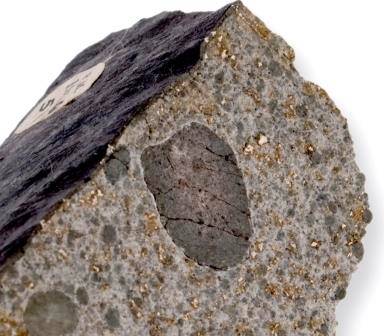Where does the Moon come from? The Moon has immense influence on the Earth – not least, the gravity that it exerts determines all sorts of biological rhythms and causes marine tides, which in turn influence currents, erosion processes and many other phenomena.
However, we don’t yet know exactly where the Moon comes from or how it was formed, and this is has been a topic of debate for well over 100 years.
There are three main hypotheses put forward:
- the first is that the Moon is a body formed elsewhere and captured by the Earth’s gravity;
- the second is that the Earth and Moon were part of a single larger body of molten material and that the Moon span off as a result of centrifugal forces; and
- third, the Giant Impact Hypothesis that suggests that a body the size of Mars collided with the Earth and the impact launched material off to orbit the Earth – the origin of the Moon.
Lydia Hallis, Mahesh Anand and Sara Russell, based in the Museum’s Mineralogy Department, collaborated with colleagues from the Open University, the British Antarctic Survey and University of Hawai’I to investigate the formation and early evolution of the lunar mantle and crust. They analysed the oxygen isotopic composition, titanium content and modal mineralogy (relative proportions of different mineral components) of a suite of lunar basalts.
Chemical elements can have different forms – isotopes – which differ slightly in atomic mass (the best known being Carbon-12 and Carbon-14). Most oxygen is in the form Oxygen-16, but some is in the forms of Oxygen-17 and Oxygen-18. Materials of different origin in the Solar System can have different ratios of these isotopes. Basalt is a common igneous rock, formed when lava emerges and cools at the surface of a planet.
The scientists’ samples included eight low-Titanium basalts from the Apollo 12 and 15 lunar mission collections, and 12 high-Titanium basalts from Apollo 11 and 17 collections. In addition, they measured the oxygen isotopic composition of an Apollo 15 KREEP (K - potassium, REE - Rare Earth Element, and P - phosphorus) basalt (sample 15386) and an Apollo 14 feldspathic mare basalt (sample 14053).
As with results of previous studies, the data reveal no detectable difference between the ratios of Oxygen isotopes in rocks of the Earth and Moon.
Large objects from elsewhere in the Solar System would be likely to have different Oxygen isotope ratios to that found in Earth rocks. Since the ratios on Earth and Moon are the same, the Giant Impact Hypothesis is open to substantial doubt: it seems more likely from this evidence that Earth and Moon were once part of the same body in the early Solar System and separated by means other than a collision – possibly by centrifugal forces.
Hallis, L.J., Anand, M., Greenwood, R.C., Miller, M.F., Franchi, I.A., Russell, S.S. (2010) The oxygen isotope composition, petrology and geochemistry of mare basalts: Evidence for large-scale compositional variation in the lunar mantle, Geochimica et Cosmochimica Acta. 74, 6885-6899. doi:10.1016/j.gca.2010.09.023



